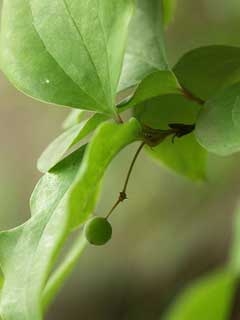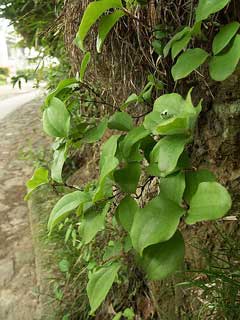 |
|
http://commons.wikimedia.org/wiki/User:Cory |
 |
| http://commons.wikimedia.org/wiki/User:Cory |
Translate this page:
Summary
Physical Characteristics

 Smilax china is a deciduous Climber growing to 4.5 m (14ft 9in).
Smilax china is a deciduous Climber growing to 4.5 m (14ft 9in).
See above for USDA hardiness. It is hardy to UK zone 6. It is in flower in May, and the seeds ripen in October. The species is dioecious (individual flowers are either male or female, but only one sex is to be found on any one plant so both male and female plants must be grown if seed is required). . The plant is not self-fertile.
Suitable for: light (sandy), medium (loamy) and heavy (clay) soils. Suitable pH: mildly acid, neutral and basic (mildly alkaline) soils. It can grow in semi-shade (light woodland) or no shade. It prefers moist soil.
UK Hardiness Map
US Hardiness Map
Synonyms
Plant Habitats
Woodland Garden Sunny Edge; Dappled Shade;
Edible Uses
Edible Parts: Fruit Leaves Root Shoots
Edible Uses: Rutin Tea
Root - cooked[4, 105, 177]. Rich in starch[2], the large and fleshy roots can be dried and ground into a powder[11]. The root is harvested by severing larger roots near the crown and leaving the smaller roots to grow on[238]. Young shoots and leaves - raw or cooked[105, 159, 177, 179]. Used as a potherb[183]. The leaves are said to contain rutin, but no details of quantity were given[218]. Fruit - raw. Eaten to quench the thirst[105, 177, 183]. The fruit is about 9mm in diameter[200]. A tea is made from the leaves[177, 179, 183].
References More on Edible Uses
Medicinal Uses
Plants For A Future can not take any responsibility for any adverse effects from the use of plants. Always seek advice from a professional before using a plant medicinally.
Alterative Antipsoriatic Antiscrophulatic Carminative Depurative Diaphoretic Diuretic Skin
Tonic Urinary VD
The root is alterative, antiscrophulatic, carminative, depurative, diaphoretic, diuretic and tonic[1, 4, 11, 147, 174, 178, 218]. It is considered useful when taken internally in the treatment of old syphilitic cases and is also used for certain skin diseases, including psoriasis, rheumatoid arthritis, gout, enteritis, urinary tract infections, skin ulcers etc[4, 238]. Large doses can cause nausea and vomiting, which is valuable in weakened and depraved conditions due to a poisoned state of the blood[4]. The root is harvested in the autumn and dried for later use.
References More on Medicinal Uses
The Bookshop: Edible Plant Books
Our Latest books on Perennial Plants For Food Forests and Permaculture Gardens in paperback or digital formats.

Edible Tropical Plants
Food Forest Plants for Hotter Conditions: 250+ Plants For Tropical Food Forests & Permaculture Gardens.
More

Edible Temperate Plants
Plants for Your Food Forest: 500 Plants for Temperate Food Forests & Permaculture Gardens.
More

More Books
PFAF have eight books available in paperback and digital formats. Browse the shop for more information.
Shop Now
Other Uses
Dye
A yellow dye is made from the root and leaves when alum is used as a mordant[4, 178]. With iron sulphate, the colour is brown[4].
Special Uses
References More on Other Uses
Cultivation details
Succeeds in most well-drained soils in sun or semi-shade[200]. Hardy to about -15°c[200]. A climbing plant, supporting itself by means of tendrils and thorns as it scrambles through small trees and shrubs. A young plant is growing and thriving close to a west-facing wall at Kew Botanical gardens[K]. This species is not the true 'China root' of medicine, see the record for S. pseudo-china[178]. Dioecious. Male and female plants must be grown if seed is required.
References Carbon Farming Information and Carbon Sequestration Information
Temperature Converter
Type a value in the Celsius field to convert the value to Fahrenheit:
Fahrenheit:
The PFAF Bookshop
Plants For A Future have a number of books available in paperback and digital form. Book titles include Edible Plants, Edible Perennials, Edible Trees,Edible Shrubs, Woodland Gardening, and Temperate Food Forest Plants. Our new book is Food Forest Plants For Hotter Conditions (Tropical and Sub-Tropical).
Shop Now
Plant Propagation
Seed - sow March in a warm greenhouse[1]. This note probably refers to the tropical members of the genus, seeds of plants from cooler areas seem to require a period of cold stratification, some species taking 2 or more years to germinate[K]. We sow the seed of temperate species in a cold frame as soon as we receive it, and would sow the seed as soon as it is ripe if we could obtain it then[K]. When the seedlings eventually germinate, prick them out into individual pots when they are large enough to handle and grow them on in the greenhouse for at least their first year, though we normally grow them on in pots for 2 years. Plant them out into their permanent positions in early summer. Division in early spring as new growth begins[238]. Larger divisions can be planted out direct into their permanent positions. We have found it best to pot up the smaller divisions and grow them on in a lightly shaded position in a cold frame, planting them out once they are well established in the summer. Cuttings of half-ripe shoots, July in a frame[238].
Other Names
If available other names are mentioned here
Native Range
TEMPERATE ASIA: China, Korea, Japan (Hokkaidô, Honshu, Kyushu, Shikoku), Taiwan
Weed Potential
Right plant wrong place. We are currently updating this section.
Please note that a plant may be invasive in one area but may not in your area so it's worth checking.
Conservation Status
IUCN Red List of Threatened Plants Status :

Growth: S = slow M = medium F = fast. Soil: L = light (sandy) M = medium H = heavy (clay). pH: A = acid N = neutral B = basic (alkaline). Shade: F = full shade S = semi-shade N = no shade. Moisture: D = dry M = Moist We = wet Wa = water.
Now available:
Food Forest Plants for Mediterranean Conditions
350+ Perennial Plants For Mediterranean and Drier Food Forests and Permaculture Gardens.
[Paperback and eBook]
This is the third in Plants For A Future's series of plant guides for food forests tailored to
specific climate zones. Following volumes on temperate and tropical ecosystems, this book focuses
on species suited to Mediterranean conditions—regions with hot, dry summers and cool, wet winters,
often facing the added challenge of climate change.
Read More
Expert comment
Author
L.
Botanical References
11200266
Links / References
For a list of references used on this page please go here
Readers comment